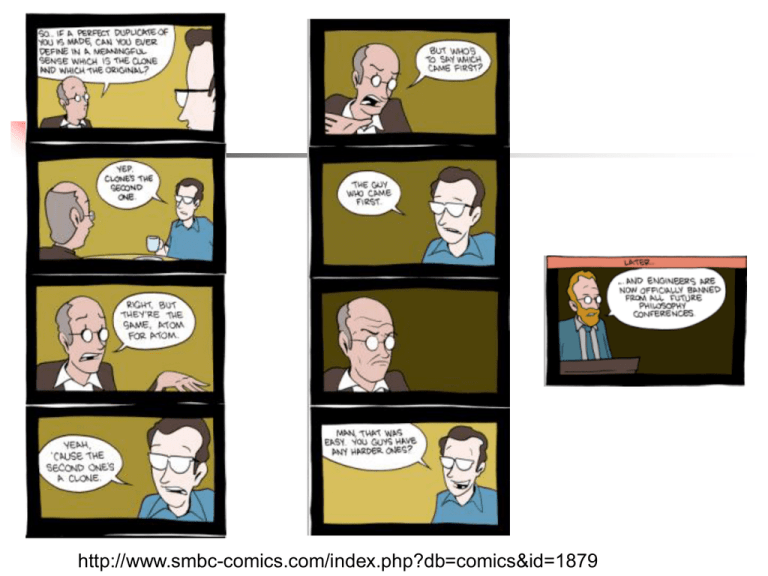AI - Philosophy and Ethics
advertisement

http://www.smbc-comics.com/index.php?db=comics&id=1879
Artificial Intelligence: Ethics
Admin
Drafts due Sunday (5/12) by 11:59pm
should look/read like a small research paper
this is NOT a project report (it’s a paper!)
Abstract
Intro
Approach/Algorithm (final version)
Results
Conclusion
I don’t want a play by play of what happened
Be creative with how you present your data
Reviews due Wednesday (5/15) by 11:59
Be constructive
Be precise (give lost of concrete examples)
Think about what feedback would be useful for you
Admin
Presentations 5/20 7-10pm
General overview
strict maximum of 15 min (10 min. if solo)
problem
motivation/application/usefulness of domain
approach/algorithm
results
this generally means ~15 slides
All people in group should participate in presentation
I’ll have my laptop if anyone needs it
Have one person in your group show up 5-10 min. before class and try out your
laptop on the projector
Attendance is required!
let me know if for some reason you have scheduling constraints
Four Broad Principals of
Data Presentation
Integration: Tables and graphics should be part of a “seamless information
flow”. Text should refer to and direct readers towards these exhibits.
Speed and Efficiency of Communication: Figures/tables should be clearly and
simply presented, well-titled, and well-labeled
Engagement in Depth: The longer the viewer spends with an exhibit, the more
they should get out of it. “The goal is to create a richly informative exhibit
that is dense with information, but open and accessible to the eye.”
Trustworthiness: Exhibits present factual information. They must be
supported with appropriate sourcing and with all information presented
correctly and understandably.
Creating good figures and tables
communicate ideas with clearly and
efficiently, .i.e. convey the most information
in the shortest time/space
Compare relationships between numerous
variables/values/ideas
tell the truth about the data
Some Rules of Thumb
show the data
avoid distorting the data
make large amounts of data coherent
encourage the viewer to use the graphic as you intend, e.g. make
comparisons
be closely integrated with written descriptions of the data
be as simple as possible
Design Guidelines
use a properly chosen format
use words, numbers, and graphics together
display an accessible complexity of detail
have a story to tell about the data
produce technical details with care
avoid clutter
Tables
“An informative table supplements rather than duplicates
- the text.” (APA 1994)
Tables “are the best way to show exact numerical values
and are preferable to graphics for many small data sets {of
about 20 numbers or less}.” (Tufte 1983)
Tend to use tables when there is no ordering to the data
Good table
Use a graph to see temporal trends
Charts/Graphs
“Figures convey at a quick glance an overall pattern of
results.”
They are especially useful in describing an interaction - or
the lack thereof - and nonlinear relations.” (APA 1994)
Figure/graph types?
Bar Charts and Graphs
Bar charts / graphs (histograms) are typically used
when you have categorical data
Source: Tallahassee 2003 CIP
Clustered Bar Chart Example
Pie Charts
Pie charts are used to illustrate percentages or
proportions of a whole
“at best, they allow readers to see crude proportions
among a few elements.” (Booth et al. 1995)
City of Tallahassee FY02
Revenues from All Sources
Utilities (66%)
Interest (1%)
Interdept (7%)
Misc (12%)
Cap Bdgt OH (1%)
Fund Balance (1%)
Taxes (8%)
InterGvtl (4%)
InterGvtl (4%)
Taxes (8%)
Fund Balance (1%)
Misc (12%)
Cap Bdgt OH (1%)
Interest (1%)
Interdept (7%)
Utilities (66%)
Line Graphs
Scatter plots and line graphs are used to show the
relation between two quantitative variables where
there is a unique value of the dependent variable for
any value of the independent variable
Line graphs are especially effective at presenting
ordered data
Percentage
Composition of Infrastructure Stocks
by National Income Level
100%
90%
80%
70%
60%
50%
40%
30%
20%
10%
0%
Power
Roads
Telecom
Railways
Irrigation
Water
Sanitation
Low Inc
Middle Inc
High Inc
Income Level
Stacked Column Chart Example
Line-Column Chart Example
Ethics
“the study of values - good and bad, right and wrong” & “quality of life
impact”
Meta-Ethics
Studying where our ethics come from
Normative Ethics
Generating moral standards for right vs. wrong
The consequences of our behaviors on others
Applied Ethics
Examining specific controversial issues (nuclear war, animal rights)
Ethics in Scientific
Research/Innovation
What are some examples of scientific research
in which ethics play a large role?
Stem cell research
Cloning/genetically modified food
Nuclear technology
Animal rights
Medical trials
Disease research (e.g. biowarfare)
…
Consequences
New technologies have unintended negative side effects
Scientists and engineers must think about:
•
•
•
how they should act on the job
what projects should or should not be done
and how they should be handled
An example
“’We are very cognizant of the
precedent we are setting’ with
the do-it-yourself project and
that some of the money raised
would be used to explore public
policy issues.”
http://www.nytimes.com/2013/05/08/business/energy-environment/a-dream-of-glowing-trees-is-assailed-for-gene-tinkering.html
Ethics in CS/Technology?
DRM (digital rights management)
Privacy
Ethics of AI
Ethics of AI
People are thinking about this:
AAAI symposium on “Machine Ethics”
1)
2)
3)
4)
5)
6)
People might lose their jobs to automation.
People might have too much (or too little) leisure time.
People might lose their sense of being unique.
People might lose some of their privacy rights.
The use of AI systems might result in a loss of accountability.
The success of AI might mean the end of the human race.
People might lose their jobs to automation
workers displaced by AI
AI does work that people can’t do because of cost (spam filters;
fraud detection in credit card transactions)
Textbook asserts:
AI has created more jobs than it has eliminated
AI has created higher paying jobs
“expert systems” were a threat, but “intelligent agents” are not
People might have too much (or too little)
leisure time.
People in 2001 might be “faced with a future of utter boredom,
where the main problem in life is deciding which of several hundred
TV channels to select.”
-Arthur C. Clarke (1968)
“working harder”
Can you think of any occupations in which people work
harder because of the creation of some technology?
Can you think of any occupations in which people work
harder because of the creation of AI technology?
People might lose their sense of
being unique.
If an AI is created, won’t that also mean that people are
equivalent to automata? Will we lose our humanity?
Threat to society argument by Weizenbaum (ELIZA)
AI research makes possible the idea that humans are
automata (self operating machine or mindless follower)
People might lose some of their
privacy rights.
‘intelligent’ scanning of electronic text, telephone
conversations, recorded conversations…
SIGKDD (Knowledge Discovery and Data Mining)
Darpa’s Terrorism Information Awareness
TSA’s CAPPS (passenger screening)
FBI’s trilogy system
Gmail and Query Logs
The use of AI systems might result in a
loss of accountability.
If an expert medical diagnosis system exists, and kills a
patient with an incorrect diagnosis, who is at fault?
Internet Agents
Autonomous Cars
Voting Systems
Law in Virtual Worlds
Second Life
The success of AI might mean
the end of the human race.
Can we encode robots or
robotic machines with some
sort of laws of ethics, or
ways to behave?
How are we expected to
treat them? (immoral to treat
them as machines?)
How are they expected to
behave?
http://www.smbccomics.com/index.php?db=comics&id=2956
Laws of Robotics
Law Zero: A robot may not injure humanity, or, through
inaction, allow humanity to come to harm.
Law One: A robot may not injure a human being, or through
inaction allow a human being to come to harm, unless this
would violate a higher order law.
Law Two: A robot must obey orders given it by human
beings, except where such orders would conflict with a
higher order law.
Law Three: A robot must protect its own existence as long
as such protection does not conflict with a higher order law.
Robot Safety
“As robots move into homes and offices, ensuring that
they do not injure people will be vital. But how?”
“Kenji Urada (born c. 1944, died 1981) was notable in that
he was one of the first individuals killed by a robot. Urada
was a 37-year old maintenance engineer at a Kawasaki
plant. While working on a broken robot, he failed to turn it off
completely, resulting in the robot pushing him into a grinding
machine with its hydraulic arm. He died as a result.”
• Over 5 million roombas sold
• By 2020, south korea wants 100% of households to have domestic robots
• Japanese firms have been working on robots as domestic help for the elderly
Robot Rights
Robot rights are like animal rights
- David J. Calverly
Examples
Robbing a bank – what if a robot robs a
bank?




